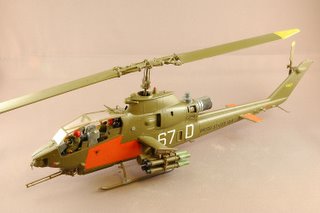
Armed helicopters came into widespread use in Vietnam in the early Sixties. Limitations of the modified armed utility helicopters used led to the specially configured attack helicopter.
Bell Helicopter (now Bell Helicopter Textron) had already evolved the first attack helicopter design, based on the use of UH-1 Huey dynamics (rotors, drives, engine) with a new fuselage. Bell also built a company-sponsored, scaled-down prototype using H-13/Model 47 series components, its Model 207 Sioux Scout.
While the Army went forward with its sophisticated AAFSS (advanced aerial fire support system) program to provide an attack helicopter, Bell proceeded with another company-sponsored prototype, Model 209, using the Huey dynamics and an airframe similar to the initial design. The 209 first flew in September 1965. The urgent need for greater armed helicopter performance in Vietnam and the success of the 209 led to Army orders for prototypes and production models of the 209 as interim attack helicopters, pending production of the AAFSS (which, finally, was never to occur).
Carried over from the 209 were the slim fuselage with tandem cockpits (gunner in front of pilot), the Lycoming T-53 engine, stub wings with store stations and the under nose turret. Its retractable skid landing gear was replaced by a fixed gear. As the AH-1G, the Huey Cobra went into combat in September 1967.
Other information:
http://www.history.navy.mil/planes/ah1.htm
http://en.wikipedia.org/wiki/AH-1_Cobra
http://www.veteranen.info/~cedarsouthlebanon/huey/huey.en.htm
No comments:
Post a Comment